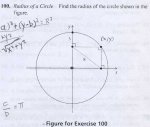
Okay, so my history regarding math is borderline pitiable-- due to anxiety disorder I wasn't able to attend much schooling. I was in and out of various programs (many of them "alternative") and due to this I missed an incredulous amount of crucial math. To make matters worse I'm supremely right-brained; hence my aptitude with words and juxtaposing platitude in most left-brain persuasions.
I'm now taking a college math class, wherein I'm struggling...to say the least.
...but I digress, onto the math!
In this equation, I know I must find the radius. I tried writing down a few formulas that seemed relevant when I consulted the almighty google about this problem.
But to be completely honest, I don't even know where to start. Someone told me I should draw an "x" through the rectangle and find the correlation between the rectangle and the circle once I've done so...I don't understand why this would solve a radius problem, since rectangles can't be calculated for radii.
My goal is to not only know how to solve this, but to have the methodology behind solving it so that I can follow those steps with unerring accuracy and reproduce a correct result in future problems.
Thanks in advance!
